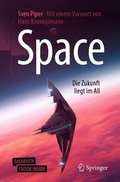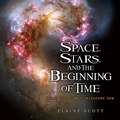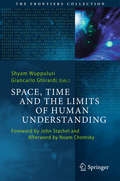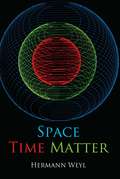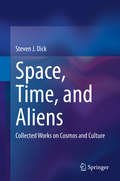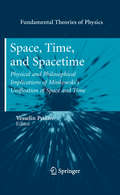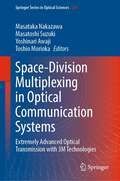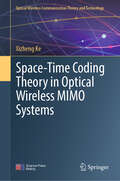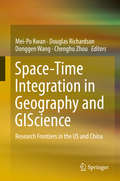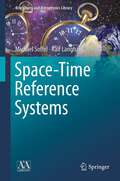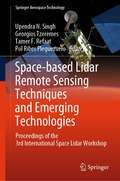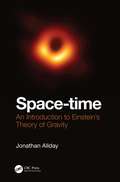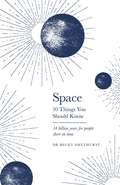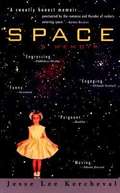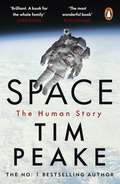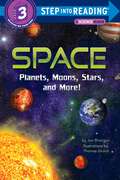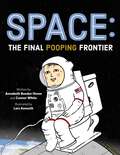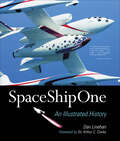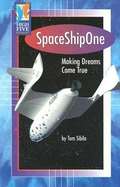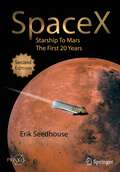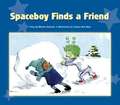- Table View
- List View
Space – Die Zukunft liegt im All
by Sven PiperDas vorliegende Buch bietet Ihnen einen Überblick über Geschichte und Entwicklung der bemannten Raumfahrt – von den ersten Ideen, den bekannten und weniger bekannten Pionieren der Raketentechnik über die Gegenwart in die Zukunft der Exploration des Weltalls. Sven Piper stellt in informativer Weise die Entwickler der Raketentechnik vor, beleuchtet den Beginn des Weltraumzeitalters mit Juri Gagarin als erster Mensch im All bis zur dauerhaft besetzten Raumstation ISS. Er beschreibt verwirklichte Träume wie die Mondlandungen des Apollo-Programms, geht aber auch Rückschläge und Projekte, die nicht umgesetzt werden konnten, ein. Der zweite Teil des Buches beschäftigt sich mit der aktuellen bemannten Raumfahrt, den Raketen und Trägersystemen und dem angehenden Weltraumtourismus. Im Anschluss daran werden futuristische Antriebssysteme, erste „Schritte“ ins Sonnensystem, permanente Mondstationen und eine bemannte Marsmission thematisiert. Das Buch schließt mit einem Blick auf die Kolonialisierung des Sonnensystems und der Erforschung des Weltalls mit Generationenschiffen oder Neumann-Sonden in ferner Zukunft.Das Buch richtet sich an raumfahrtbegeisterte Leser, die sich für die Fortschritte der Raumfahrt in der Vergangenheit und möglichen Zukunftsszenarien interessieren.Der Autor Sven Piper studierte Engineering and Project Management (EPM) an der Fachhochschule Südwestfalen in Soest und absolvierte einen Executive Master of Business Administration (EMBA) Studiengang des Centrums für Unternehmensrechnung (CUR) der Westfälischen Wilhelms-Universität Münster. Seit 2014 arbeitet er beim Deutschen Zentrum für Luft- und Raumfahrt (DLR) und war bereits zuvor mehrere Jahre in der europäischen Luft- und Raumfahrtindustrie beschäftigt.
Space, Place, and Gendered Violence in South African Writing
by Sorcha GunneGendered violence constitutes a unique form of violence because it is at once both intensely political and intensely personal. Exploring the relationship between space, place, and gendered violence as depicted in a range of South African writing, Gunne examines the social and political conditions of exceptionality during and after apartheid. As a case study, South Africa offers considerable potential for analysis because the governmental technology of apartheid affected not only race relations, but also gendered and spatial ones. This resulted in conditions of exceptionality that operate on the levels of institutional power and political allegory, but yet had, and still have, an immense impact on the everyday. This book focuses on how narrative representations of gendered violence document, negotiate, challenge and resist structures of domination and power.
Space, Stars, and the Beginning of Time: What the Hubble Telescope Saw
by Elaine ScottThrough the eye of the Hubble Telescope, Elaine Scott skillfully guides readers along the evolution of our universe, investigating a question that was once unanswerable: “Where did we come from?”
Space, Time and the Limits of Human Understanding
by Shyam Wuppuluri Giancarlo GhirardiIn this compendium of essays, some of the world's leading thinkers discuss their conceptions of space and time, as viewed through the lens of their own discipline. With an epilogue on the limits of human understanding, this volume hosts contributions from six or more diverse fields. It presumes only rudimentary background knowledge on the part of the reader. Time and again, through the prism of intellect, humans have tried to diffract reality into various distinct, yet seamless, atomic, yet holistic, independent, yet interrelated disciplines and have attempted to study it contextually. Philosophers debate the paradoxes, or engage in meditations, dialogues and reflections on the content and nature of space and time. Physicists, too, have been trying to mold space and time to fit their notions concerning micro- and macro-worlds. Mathematicians focus on the abstract aspects of space, time and measurement. While cognitive scientists ponder over the perceptual and experiential facets of our consciousness of space and time, computer scientists theoretically and practically try to optimize the space-time complexities in storing and retrieving data/information. The list is never-ending. Linguists, logicians, artists, evolutionary biologists, geographers etc. , all are trying to weave a web of understanding around the same duo. However, our endeavour into a world of such endless imagination is restrained by intellectual dilemmas such as: Can humans comprehend everything? Are there any limits? Can finite thought fathom infinity? We have sought far and wide among the best minds to furnish articles that provide an overview of the above topics. We hope that, through this journey, a symphony of patterns and tapestry of intuitions will emerge, providing the reader with insights into the questions: What is Space? What is Time? Chapter [15] of this book is available open access under a CC BY 4. 0 license.
Space, Time, Matter (Dover Books On Physics Series)
by Hermann WeylReflecting the revolution in scientific and philosophic thought which accompanied the Einstein relativity theories, Dr. Weyl has probed deeply into the notions of space, time, and matter. A rigorous examination of the state of our knowledge of the world following these developments is undertaken with this guiding principle: that although further scientific thought may take us far beyond our present conception of the world, we may never again return to the previous narrow and restricted scheme.Although a degree of mathematical sophistication is presupposed, Dr. Weyl develops all the tensor calculus necessary to his exposition. He then proceeds to an analysis of the concept of Euclidean space and the spatial conceptions of Riemann. From this the nature of the amalgamation of space and time is derived. This leads to an exposition and examination of Einstein's general theory of relativity and the concomitant theory of gravitation. A detailed investigation follows devoted to gravitational waves, a rigorous solution of the problem of one body, laws of conservation, and the energy of gravitation. Dr. Weyl's introduction of the concept of tensor-density as a magnitude of quantity (contrasted with tensors which are considered to be magnitudes of intensity) is a major step toward a clearer understanding of the relationships among space, time, and matter.
Space, Time, and Aliens: Collected Works on Cosmos and Culture
by Steven J. DickIn this comprehensive and interdisciplinary volume, former NASA Chief Historian Steven Dick reflects on the exploration of space, astrobiology and its implications, cosmic evolution, astronomical institutions, discovering and classifying the cosmos, and the philosophy of astronomy. The unifying theme of the book is the connection between cosmos and culture, or what Carl Sagan many years ago called the “cosmic connection.”As both an astronomer and historian of science, Dr. Dick has been both a witness to and a participant in many of the astronomical events of the last half century. This collection of papers presents his reflections over the last forty years in a way accessible to historians, philosophers, and scientists alike. From the search for alien life to ongoing space exploration efforts, readers will find this volume full of engaging topics relevant to science, society, and our collective future on planet Earth and beyond.
Space, Time, and Spacetime
by Vesselin PetkovThis volume is dedicated to the centennial anniversary of Minkowski's discovery of spacetime. It contains selected papers by physicists and philosophers on the Nature and Ontology of Spacetime. The first six papers, comprising Part I of the book, provide examples of the impact of Minkowski's spacetime representation of special relativity on the twentieth century physics. Part II also contains six papers which deal with implications of Minkowski's ideas for the philosophy of space and time. The last part is represented by two papers which explore the influence of Minkowski's ideas beyond the philosophy of space and time.
Space-Division Multiplexing in Optical Communication Systems: Extremely Advanced Optical Transmission with 3M Technologies (Springer Series in Optical Sciences #236)
by Masataka Nakazawa Masatoshi Suzuki Yoshinari Awaji Toshio MoriokaThis book presents new frontiers in data communication. To transcend the physical limitations of current optical communication technologies, totally new multiplexing schemes beyond TDM/WDM, novel transmission optical fibers handling well above Pbit/s capacity, and next-generation optical submarine cable systems will need to be developed. The book offers researchers working at the forefront, as well as advanced Ph.D. students in the area of optical fiber communications systems and related fields, an essential guide to state-of-the-art optical transmission technologies. It explores promising new technologies for the exabit era; namely, the three “M technologies”: multi-level modulation, multi-core fiber, and multi-mode control.
Space-Time Coding Theory in Optical Wireless MIMO Systems (Optical Wireless Communication Theory and Technology)
by Xizheng KeThis book is divided into 12 chapters, including introduction, multi-aperture transmit/receive technology in turbulent atmosphere, channel model and channel capacity, orthogonal space-time block coding, layered space-time coding, hybrid space-time coding, space-time trellis coding, differential space-time coding, unitary space-time coding, adaptive layered space-time coding, performance analysis of indoor MIMO-VLC system, and detection algorithm of MIMO technology. The key technologies of wireless optical MIMO systems are introduced, and the basic framework of space-time coding of wireless optical MIMO systems is proposed.
Space-Time Foliation in Quantum Gravity
by Yuki SatoIn this thesis, the author considers quantum gravity to investigate the mysterious origin of our universe and its mechanisms. He and his collaborators have greatly improved the analyticity of two models: causal dynamical triangulations (CDT) and n-DBI gravity, with the space-time foliation which is one common factor shared by these two separate models. In the first part, the analytic method of coupling matters to CDT in 2-dimensional toy models is proposed to uncover the underlying mechanisms of the universe and to remove ambiguities remaining in CDT. As a result, the wave function of the 2-dimensional universe where matters are coupled is derived. The behavior of the wave function reveals that the Hausdorff dimension can be changed when the matter is non-unitary. In the second part, the n-DBI gravity model is considered. The author mainly investigates two effects driven by the space-time foliation: the appearance of a new conserved charge in black holes and an extra scalar mode of the graviton. The former implies a breakdown of the black-hole uniqueness theorem while the latter does not show any pathological behavior.
Space-Time Integration in Geography and GIScience
by Donggen Wang Chenghu Zhou Mei-Po Kwan Douglas RichardsonSpace-time analysis is a rapidly growing research frontier in geography, GIS, and GIScience. Advances in integrated GPS/GIS technologies, the availability of large datasets (over time and space), and increased capacity to manage, integrate, model and visualize complex data in (near) real time, offer the GIS and geography communities extraordinary opportunities to begin to integrate sophisticated space-time analysis and models in the study of complex environmental and social systems, from climate change to infectious disease transmission. This volume specifically focuses on research frontiers, comparative research, and research and application interactions in this field in the US and China, arguably the two most dynamic loci for this work today. The contributions to this book, by top researchers in China and the US, productively highlight the differences and similarities in approaches and directions for space-time analysis in the two countries. In light of the recent rapid progress in GIScience research on space-time integration in both countries, the book's focus on research frontiers in these two countries will attract great interest in both countries and in other parts of the world as well as among related disciplines. In addition, the book also explores the impact of collaborative research and publications underway in this area between the US and China and will provide an overview of these collaborative efforts and programs. This book will not only be of interest to university-based GIS researchers and students, but also to those interested in this new area of research and applications like researchers and developers in business, internet mapping and GIS and location based services (LBS).
Space-Time Reference Systems
by Michael Soffel Ralf LanghansThe high accuracy of modern astronomical spatial-temporal reference systems has made them considerably complex. This book offers a comprehensive overview of such systems. It begins with a discussion of 'The Problem of Time', including recent developments in the art of clock making (e.g., optical clocks) and various time scales. The authors address the definitions and realization of spatial coordinates by reference to remote celestial objects such as quasars. After an extensive treatment of classical equinox-based coordinates, new paradigms for setting up a celestial reference system are introduced that no longer refer to the translational and rotational motion of the Earth. The role of relativity in the definition and realization of such systems is clarified. The topics presented in this book are complemented by exercises (with solutions). The authors offer a series of files, written in Maple, a standard computer algebra system, to help readers get a feel for the various models and orders of magnitude. Beyond astrometry, the main fields of application of high-precision astronomical spatial-temporal reference systems and frames are navigation (GPS, interplanetary spacecraft navigation) and global geodynamics, which provide a high-precision Celestial Reference System and its link to any terrestrial spatial-temporal reference system. Mankind's urgent environmental questions can only be answered in the context of appropriate reference systems in which both aspects, space and time, are realized with a sufficiently high level of accuracy. This book addresses all those interested in high-precision reference systems and the various techniques (GPS, Very Long Baseline Interferometry, Satellite Laser Ranging, Lunar Laser Ranging) necessary for their realization, including the production and dissemination of time signals.
Space-Time Structure
by Erwin SchrödingerReprint of a classical book first published in 1950. This lucid and profound exposition of Einstein's 1915 theory of gravitation is essential reading.
Space-based Lidar Remote Sensing Techniques and Emerging Technologies: Proceedings of the 3rd International Space Lidar Workshop (Springer Aerospace Technology)
by Upendra N. Singh Georgios Tzeremes Tamer F. Refaat Pol Ribes PleguezueloThis book gathers the latest advances, innovations, and applications in the field of space lidar missions, techniques, and technologies, as presented at the 3rd International Workshop on Space-Based Lidar Remote Sensing Techniques and Emerging Technologies (LIDAR), held in Milos Island, Greece, on June 18–23, 2023. It covers highly diverse topics such as space-based lidar techniques and methodologies; challenges experienced in space lidar missions; planning of new space earth observation lidar missions, including monitoring of topography, cryosphere, biomass, greenhouse and trace gases clouds, aerosols; exploration lidars, including entry, decent and precision landing, as well as hazard avoidance for Mars & Lunar landers missions; results and plans for simulations, airborne experiments and demonstrations as precursors for space missions; emerging space lidar technologies, particularly in lasers, optics, electronics and detectors as well as space lidar reliability and influencing factors, such as effects of the space environment. Written by leading scientists and technologists from government agencies, industries and universities, and selected by means of a rigorous international peer-review process, the contributions highlight numerous exciting ideas that will spur novel research directions and foster multidisciplinary collaborations.
Space-time: An Introduction to Einstein's Theory of Gravity
by Jonathan AlldayThis book, suitable for interested post-16 school pupils or undergraduates looking for a supplement to their course text, develops our modern view of space-time and its implications in the theories of gravity and cosmology. While aspects of this topic are inevitably abstract, the book seeks to ground thinking in observational and experimental evidence where possible. In addition, some of Einstein’s philosophical thoughts are explored and contrasted with our modern views. Written in an accessible yet rigorous style, Jonathan Allday, a highly accomplished writer, brings his trademark clarity and engagement to these fascinating subjects, which underpin so much of modern physics. Features: Restricted use of advanced mathematics, making the book suitable for post-16 students and undergraduates Contains discussions of key modern developments in quantum gravity, and the latest developments in the field, including results from the Laser Interferometer Gravitational-Wave Observatory (LIGO) Accompanied by appendices on the CRC Press website featuring detailed mathematical arguments for key derivations
Space: 10 Things You Should Know
by Rebecca Smethurst'Bite-sized, cutting edge science delivered with enormous enthusiasm - all you need to travel the cosmos' CHRIS LINTOTT 'A lot of astrophysics is packed into this neat little book . . . I guarantee you will come away knowing your dark matter from your supermassive black holes' JIM AL-KHALILI This book is for anyone who wants to easily understand the mind-blowing fundamentals of our extraordinary, expanding universe.Written by Oxford astrophysicist Dr Becky Smethurst and composed of ten captivating, simple essays, it guides you swiftly through the galaxies, explaining the mysteries of black holes, dark matter and what existed before the Big Bang, presenting the evidence as to whether we really are alone, illuminating what we still don't know, and much more besides.If you have big questions about Space, this book will provide you with the answers in an engaging and succinct way.
Space: A Memoir
by Jesse Lee KerchevalKercheval remembers her days growing up in Florida, her mother addicted to Valium and her father turning into a workaholic.
Space: A thrilling human history by Britain's beloved astronaut Tim Peake
by Tim PeakeFrom bestselling author and British astronaut Tim Peake, an inspirational human history of space travel, from the Apollo missions to our future forays to Mars. The Right Stuff for a new generation.'This book is brilliant - once in a blue moon. A book for the whole family.' Chris Evans, Virgin Radio'The most wonderful book ... Tim Peake is a historian and encyclopaedia of space.’ Rory Stewart'An extraordinary book. For anyone - even if you’re not interested in Space. If you’re interested in human stories and the human character - this is delightful.' BBC Breakfast'A fascinating, detailed, playful book drawn from extensive research – Peake met seven Apollo astronauts, Russian cosmonauts and various other space technicians – as well as his considerable personal experience. Lifts the lid on what space is like: the dedication and sacrifice; the politics and pantomime; the practicalities and the peril; the glory and fame; the adjustment back to normal life.' iPaper'A thrilling human history of space' Daily Mirror'The bible of space travel' Chris Moyles, Radio XAs seen in the major TV series Secrets of Our Universe with Tim Peake.Only 656 people in human history have left Earth. In Space: The Human Story, astronaut Tim Peake traces the lives of these remarkable men and women who have forged the way, from Yuri Gagarin to Neil Armstrong, from Valentina Tereshkova to Peggy Whitson.Full of exclusive new stories, and astonishing detail only an astronaut would know, the book conveys what space exploration is really like: the wondrous view of Earth, the surreal weightlessness, the extraordinary danger, the surprising humdrum, the unexpected humour, the newfound perspective, the years of training, the psychological pressures, the gruelling physical toll, the thrill of launch and the trepidation of re-entry. The book also examines the surprising, shocking and often poignant stories of astronauts back on Earth, whose lives are forever changed as they readjust to terra firma.Publication of the book comes on the eve of NASA's plans to return to the moon, fifty years after an astronaut last walked on the lunar surface. In 2024 the Artemis II mission will send four astronauts to orbit the moon. In 2025 Artemis III will send the first woman and the first person of colour to step on the lunar surface. What will separate these upcoming moonwalkers from the legendary Apollo crews? Does it still take a daring-do attitude, super-human fitness, intelligence, plus the 'Right-stuff' - a fabled grace under pressure? And how will astronauts travel even further - to Mars and beyond? Space: The Human Story reveals all.
Space: Planets, Moons, Stars, And More! (Step into Reading)
by Joe RhatiganLearn about our solar system in this Step 3 Science Reader packed with NASA photos and space facts! Step into Reading, the most trusted name in early readers, delivers an introduction to the final frontier that kids can read themselves! For up-to-date information (including about Pluto and its fellow dwarf planets) and stellar photos and illustrations, kids eager for mind-blowing nonfiction need look no further! Step 3 Readers feature engaging characters in easy-to-follow plots about popular topics. They are ideal for children who are ready to read on their own.
Space: The Final Pooping Frontier
by Connor White Annabeth Bondor-StoneDiscover the down and dirty scientific history of astronauts pooping in space in this funny and factual picture book.Everybody poops. So, what’s an astronaut to do when hurtling through space with zero gravity and zero privacy? Go boldly.This is a scientific history of pooping in space. From the earliest NASA missions up through the innovative results of their recent Space Poop Challenge design competition, we’ll see the evolution of pooping on the final frontier. With fascinating facts and a few mishaps and discarded technologies along the way, we’ll learn why it’s so hard to deal with waste management in space.
Space: The Next Business Frontier
by H. P. Newquist Lou DobbsFrom the Publisher With the collapse of the dot-com stocks, investors are anxiously considering what sector will provide the next leap forward with spectacular returns. Lou Dobbs, the best-known personality in America in broadcast financial journalism, co-founder of CNNfn and CNN's Moneyline and current twice-weekly on-air commentator for the Today Show and the Infinity Broadcasting Network on radio believes that the answer comes in five letters: SPACE. In Space: The Next Business Frontier, Dobbs and co-author HP Newquist explore where the money will go, which new technologies will emerge as winners, and which corporations and countries will win or lose. Space: The Next Business Frontier is a crucial examination of an industry which may someday dwarf the internet itself.
SpaceShipOne: An Illustrated History
by Dan Linehan“One of the most remarkable accomplishments in our conquest of gravity.” — Sir Arthur C. Clarke In April, 2003, a company called Scaled Composites introduced SpaceShipOne to the world. SpaceShipOne: An Illustrated History chronicles the development of the world’s first commercial manned space program—aprogram that includes an airborne launcher (the White Knight), a space ship (SpaceShipOne), rocket propulsion, avionics, simulator, and full ground support. With ample illustrations, photographs, and behind-the-scenes information, SpaceShipOne provides a full picture of this classified project. The story of SpaceShipOne combines the adventurous spirit of Charles Lindbergh, the entrepreneurial drive of Howard Hughes, and the urgency of the space race at the height of the Cold War.
SpaceShipOne: Making Dreams Come True
by Tom SibilaDescribes the spacecraft known as SpaceShipOne, and explains its adventures into space in 2004.
SpaceX: Starship to Mars – The First 20 Years (Springer Praxis Books)
by Erik SeedhouseLearn about commercial spaceflight’s most successful startup in this fully updated book, which follows the extraordinary feats of engineering and human achievement that have placed SpaceX at the forefront of the launch industry and positioned it as the most likely candidate for transporting humans to Mars. This second edition emphasizes SpaceX's much-hyped manned mission to the Red Planet. With a plethora of new material gathered from 2013 to the present, the text offers the most up-to-date portrait of the maverick band of scientists and engineers producing some of the most spectacular aviation triumphs of the 21st century. Topics covered in this book include: all CRS flights, the challenges of developing retro-propulsion, and the pathway towards realizing the Falcon Heavy and BFR. In addition, the chapters describe SpaceX’s emphasis on simplicity, low-cost, and reliability, and the methods the company employs to reduce its costs while speeding up decision-making and delivery. Detailing the Falcon 1, Falcon 9 and Falcon Heavy launch vehicles, the book shows how SpaceX is able to offer a full spectrum of light, medium, and heavy lift launch capabilities to its customers and how it is able to deliver spacecraft into any inclination and altitude, from low Earth orbit to geosynchronous orbit to planetary missions. This book is the perfect go-to guide on SpaceX for anybody working or interested in the commercial space arena.
Spaceboy Finds a Friend (Spaceboy #Set 1)
by Michele DufresneAfter landing earth, the spaceboy wanted to befriend a man but felt disappointed as he was a snowman. But he was lucky to get a good friend.
